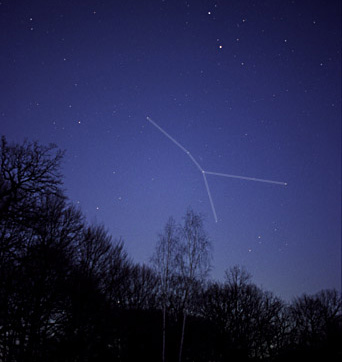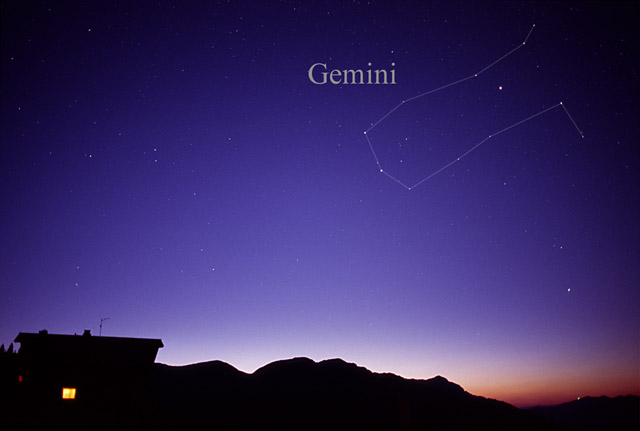|
Beehive Cluster
The Beehive Cluster (also known as Praesepe (Latin for "manger" or "crib"), M44, NGC 2632, or Cr 189), is an open cluster in the constellation Cancer. One of the nearest open clusters to Earth, it contains a larger population of stars than other nearby bright open clusters holding around 1,000 stars. Under dark skies, the Beehive Cluster looks like a small nebulous object to the naked eye, and has been known since ancient times. Classical astronomer Ptolemy described it as a "nebulous mass in the breast of Cancer". It was among the first objects that Galileo studied with his telescope. Age and proper motion coincide with those of the Hyades, suggesting they may share similar origins. Both clusters also contain red giants and white dwarfs, which represent later stages of stellar evolution, along with many main sequence stars. Distance to M44 is often cited to be between 160 and 187 parsecs (520–610 light years), but the revised Hipparcos parallaxes (2009) for Praesepe membe ... [...More Info...] [...Related Items...] OR: [Wikipedia] [Google] [Baidu] |
Cancer (constellation)
Cancer is one of the twelve constellations of the zodiac and is located in the Northern celestial hemisphere. Its old astronomical symbol is (♋︎). Its name is Latin for crab and it is commonly represented as one. Cancer is a medium-size constellation with an area of 506 square degrees and its stars are rather faint, its brightest star Beta Cancri having an apparent magnitude of 3.5. It contains two stars with known planets, including 55 Cancri, which has five: one super-earth and four gas giants, one of which is in the habitable zone and as such has expected temperatures similar to Earth. At the (angular) heart of this sector of our celestial sphere is Praesepe (Messier 44), one of the closest open clusters to Earth and a popular target for amateur astronomers. Characteristics Cancer is a medium-sized constellation that is bordered by Gemini to the west, Lynx to the north, Leo Minor to the northeast, Leo to the east, Hydra to the south, and Canis Minor to the southwe ... [...More Info...] [...Related Items...] OR: [Wikipedia] [Google] [Baidu] |
Astronomical Journal
''The Astronomical Journal'' (often abbreviated ''AJ'' in scientific papers and references) is a peer-reviewed monthly scientific journal owned by the American Astronomical Society (AAS) and currently published by IOP Publishing. It is one of the premier journals for astronomy in the world. Until 2008, the journal was published by the University of Chicago Press on behalf of the AAS. The reasons for the change to the IOP were given by the society as the desire of the University of Chicago Press to revise its financial arrangement and their plans to change from the particular software that had been developed in-house. The other two publications of the society, the ''Astrophysical Journal'' and its supplement series, followed in January 2009. The journal was established in 1849 by Benjamin A. Gould. It ceased publication in 1861 due to the American Civil War, but resumed in 1885. Between 1909 and 1941 the journal was edited in Albany, New York. In 1941, editor Benjamin Boss arranged ... [...More Info...] [...Related Items...] OR: [Wikipedia] [Google] [Baidu] |
Wilhelm Schur
Adolph Christian Wilhelm Schur, RAS Associate (15 April 1846 – 1 July 1901) was a German astronomer and professor of astronomy at the University of Göttingen. He held important positions at multiple observatories throughout his career, namely deputy director of the Strasbourg Observatory and director of the Göttingen Observatory. His main work was in astrometry, although he focused on publishing astronomical catalogues in his later life. Early life Wilhelm Schur was born on 15 April 1846 in Altona, Hamburg, to the wine merchant Friedrich Wilhelm Schur and his wife Johanna Tormählen. Schur showed mathematical prowess early in his life, entering and winning a mathematics competition organised by the Educational Association of Schleswig-Holstein and Lauenburg at the age of 14. As grandson of Adolph Cornelius Petersen (28 July 1804 – 3 February 1854), the director of the Altona Observatory, Schur took numerous opportunities to acquaint himself with astronomy. Following Peter ... [...More Info...] [...Related Items...] OR: [Wikipedia] [Google] [Baidu] |
Nicolas Louis De Lacaille
Abbé Nicolas-Louis de Lacaille (; 15 March 171321 March 1762), formerly sometimes spelled de la Caille, was a French astronomer and geodesist who named 14 out of the 88 constellations. From 1750 to 1754, he studied the sky at the Cape of Good Hope in present-day South Africa. Lacaille observed over 10,000 stars using just a half-inch refracting telescope. Biography Born at Rumigny in the Ardennes in eastern France, he attended school in Mantes-sur-Seine (now Mantes-la-Jolie). Afterwards, he studied rhetoric and philosophy at the Collège de Lisieux and then theology at the Collège de Navarre. He was left destitute in 1731 by the death of his father, who had held a post in the household of the duchess of Vendôme. However, he was supported in his studies by the Duc de Bourbon, his father's former patron. After he graduated, he did not accept ordination as a priest but took deacon's orders, becoming an Abbé. He concentrated thereafter on science, and, through the patrona ... [...More Info...] [...Related Items...] OR: [Wikipedia] [Google] [Baidu] |
Pleiades
The Pleiades (), also known as The Seven Sisters, Messier 45 and other names by different cultures, is an asterism and an open star cluster containing middle-aged, hot B-type stars in the north-west of the constellation Taurus. At a distance of about 444 light years, it is among the nearest star clusters to Earth. It is the nearest Messier object to Earth, and is the most obvious cluster to the naked eye in the night sky. It is also observed to house the reflection nebula NGC 1432, an HII Ionized region. The cluster is dominated by hot blue luminous stars that have formed within the last 100 million years. Reflection nebulae around the brightest stars were once thought to be left over material from their formation, but are now considered likely to be an unrelated dust cloud in the interstellar medium through which the stars are currently passing. This dust cloud is estimated to be moving at a speed of approximately 18 km/s relative to the stars in the cluster. Computer sim ... [...More Info...] [...Related Items...] OR: [Wikipedia] [Google] [Baidu] |
Orion Nebula
The Orion Nebula (also known as Messier 42, M42, or NGC 1976) is a diffuse nebula situated in the Milky Way, being south of Orion's Belt in the constellation of Orion. It is one of the brightest nebulae and is visible to the naked eye in the night sky with apparent magnitude 4.0. It is away and is the closest region of massive star formation to Earth. The M42 nebula is estimated to be 24 light-years across (so its apparent size from Earth is approximately 1 degree). It has a mass of about 2,000 times that of the Sun. Older texts frequently refer to the Orion Nebula as the Great Nebula in Orion or the Great Orion Nebula. The Orion Nebula is one of the most scrutinized and photographed objects in the night sky and is among the most intensely studied celestial features.Press release,Astronomers Spot The Great Orion Nebula's Successor", Harvard-Smithsonian Center for Astrophysics, 2006. The nebula has revealed much about the process of how stars and planetary systems are form ... [...More Info...] [...Related Items...] OR: [Wikipedia] [Google] [Baidu] |
Messier Object
The Messier objects are a set of 110 astronomical objects catalogued by the French astronomer Charles Messier in his ''Catalogue des Nébuleuses et des Amas d'Étoiles'' (''Catalogue of Nebulae and Star Clusters''). Because Messier was only interested in finding comets, he created a list of those non-comet objects that frustrated his hunt for them. The compilation of this list, in collaboration with his assistant Pierre Méchain, is known as ''the Messier catalogue''. This catalogue of objects is one of the most famous lists of astronomical objects, and many Messier objects are still referenced by their Messier numbers. The catalogue includes most of the astronomical deep-sky objects that can easily be observed from Earth's Northern Hemisphere; many Messier objects are popular targets for amateur astronomers. A preliminary version first appeared in 1774 in the ''Memoirs'' of the French Academy of Sciences for the year 1771. The first version of Messier's catalogue contain ... [...More Info...] [...Related Items...] OR: [Wikipedia] [Google] [Baidu] |
Charles Messier
Charles Messier (; 26 June 1730 – 12 April 1817) was a French astronomer. He published an astronomical catalogue consisting of 110 nebulae and star clusters, which came to be known as the ''Messier objects''. Messier's purpose for the catalogue was to help astronomical observers distinguish between permanent and transient visually diffuse objects in the sky. Biography Messier was born in Badonviller in the Lorraine region of France, the tenth of twelve children of Françoise B. Grandblaise and Nicolas Messier, a Court usher. Six of his brothers and sisters died while young, and his father died in 1741. Charles' interest in astronomy was stimulated by the appearance of the great six-tailed comet in 1744 and by an annular solar eclipse visible from his hometown on 25 July 1748. In 1751, Messier entered the employ of Joseph Nicolas Delisle, the astronomer of the French Navy, who instructed him to keep careful records of his observations. Messier's first doc ... [...More Info...] [...Related Items...] OR: [Wikipedia] [Google] [Baidu] |
Guide Star
In astronomy, a guide star is a reference star used to accurately maintain the tracking by a telescope of a celestial body, whose apparent motion through the sky is primarily due to Earth's rotation. Accurate telescope pointing and tracking is critical for obtaining good astronomical images and astrophotographs. However, because Earth rotates, the sky appears to be in a constant state of motion relative to Earth. Although this movement appears to be relatively slow when viewed with the naked eye, with the high magnification and consequently smaller field of view provided by even a small telescope, this motion becomes apparent on timescales of the order of seconds. Though space telescopes are not mounted on a spinning planet, they still use guide stars including those listed in the HST Guide Star Catalog. Computer-controlled electric motors are commonly employed to allow the telescope to move in sync with the apparent motion of the sky, according to a pre-computed pointing mo ... [...More Info...] [...Related Items...] OR: [Wikipedia] [Google] [Baidu] |
Pollux (star)
Pollux is the brightest star in the constellation of Gemini. It has the Bayer designation β Geminorum, which is Latinised to Beta Geminorum and abbreviated Beta Gem or β Gem. This is an orange-hued, evolved giant star located at a distance of 34 light-years, making it the closest giant to the Sun. Since 1943, the spectrum of this star has served as one of the stable anchor points by which other stars are classified. In 2006 an extrasolar planet (designated Pollux b or β Geminorum b, later named Thestias) was confirmed to be orbiting it. Nomenclature ''β Geminorum'' ( Latinised to ''Beta Geminorum'') is the star's Bayer designation. The traditional name ''Pollux'' refers to the twins Castor and Pollux in Greek and Roman mythology. In 2016, the International Astronomical Union organized a Working Group on Star Names (WGSN) to catalog and standardize proper names for stars. The WGSN's first bulletin of July 2016 included a table of the first two batches ... [...More Info...] [...Related Items...] OR: [Wikipedia] [Google] [Baidu] |
Castor (star)
Castor is the second-brightest object in the zodiac constellation of Gemini. It has the Bayer designation α Geminorum, which is Latinised to Alpha Geminorum and abbreviated Alpha Gem or α Gem. With an apparent visual magnitude of 1.93, it is one of the brightest stars in the night sky. Castor appears singular to the naked eye, but it is actually a sextuple star system organized into three binary pairs. Although it is the 'α' (alpha) member of the constellation, it is fainter than 'β' (beta) Geminorum, Pollux. Stellar system Hierarchy of orbits in the Castor system Castor is a multiple star system made up of six individual stars; there are three visual components, all of which are spectroscopic binaries. Appearing to the naked eye as a single star, Castor was first recorded as a double star in 1718 by James Pound, but it may have been resolved into at least two sources of light by Cassini as early as 1678. The separation between the binar ... [...More Info...] [...Related Items...] OR: [Wikipedia] [Google] [Baidu] |
Regulus
Regulus is the brightest object in the constellation Leo and one of the brightest stars in the night sky. It has the Bayer designation designated α Leonis, which is Latinized to Alpha Leonis, and abbreviated Alpha Leo or α Leo. Regulus appears singular, but is actually a quadruple star system composed of four stars that are organized into two pairs. The spectroscopic binary Regulus A consists of a blue-white main-sequence star and its companion, which has not yet been directly observed, but is probably a white dwarf. The system lies approximately 79 light years from the Sun. HD 87884 is separated from Regulus by and is itself a close pair. Regulus, along with five slightly dimmer stars (Zeta Leonis, Mu Leonis, Gamma Leonis, Epsilon Leonis, and Eta Leonis) have collectively been called 'the Sickle', which is an asterism that marks the head of Leo. Nomenclature ''α Leonis'' (Latinized to ''Alpha Leonis'') is the star system's Bayer designation. The traditional ... [...More Info...] [...Related Items...] OR: [Wikipedia] [Google] [Baidu] |










